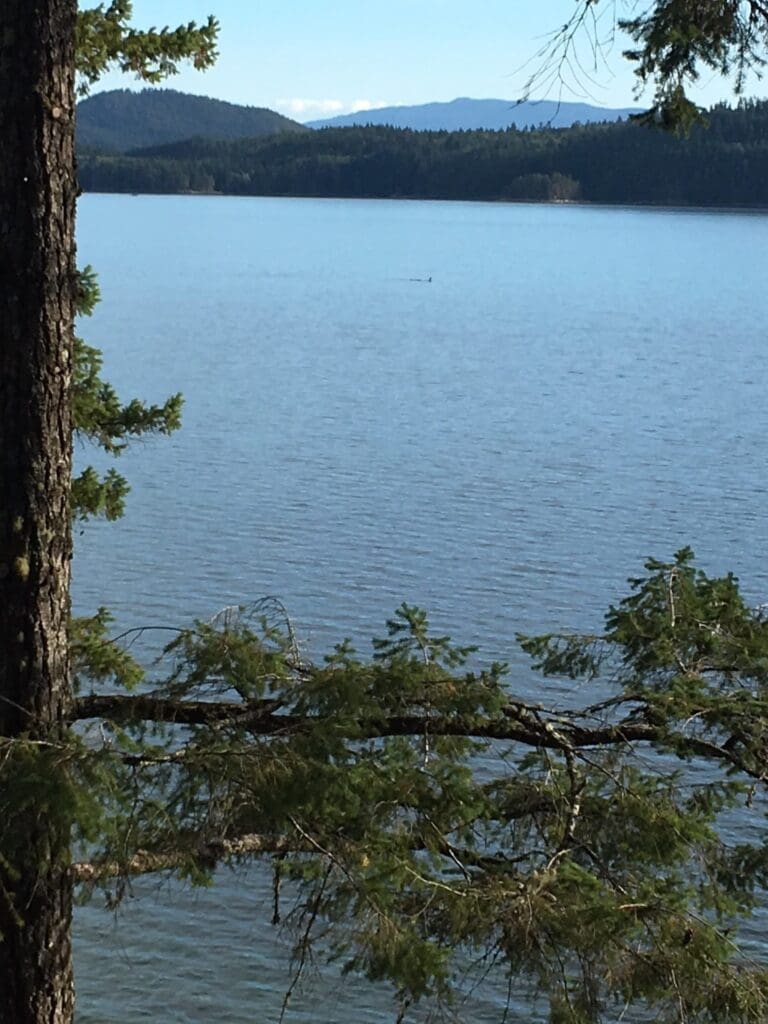
From our front deck we spied the resident orca family – two calves, mom and dad – moving east toward the mouth of Jervis Inlet.
 When you live in the coastal rainforest, you learn the natural indicators that presage seasonal change.
When you live in the coastal rainforest, you learn the natural indicators that presage seasonal change.
The mornings are getting darker, the days are becoming shorter and the evenings are definitely cooler. We swam on Sept. 3 but the ocean was noticeably colder. And we spent less time out front going through our exercise routines that were developed during the warm water months of June, July and August.
On Sept. 1, we saw the normally resident orca family for only the second time this summer. From our front deck we spied them, two calves, mom and dad, moving east toward the mouth of Jervis Inlet, which faces Texada Island and is bounded by Ball and Scotchfir Points.
This family pod is unmistakable in both its hunting behaviour and the size of the dad’s dorsal fin. They often hunt by swimming in a tight group, close along the rocky edges of the inlet, picking off sleeping harbour seals and Steller sea lions. The dad’s dorsal fin is a wonder of nature: V-shaped, dark black, about five feet high. It’s obviously diagnostic. Locally he is called “the big guy.”
Their most recent transit by Skelhp was clearly planned further up the inlet. They were incredibly purposeful, staying almost dead centre of the channel and heading directly for McRae Islets, a granite rock outcrop just hidden from our view by the Douglas fir-clad profile of Scotchfir Point.
We knew exactly what they had in mind. McRae Islets are the home of about 100 Steller sea lions. They’re dominated by an enormous male, which always occupies the highest point of the highest rock. He bellows frequently when adolescent males attempt to haul-out into the writhing mass of his Steller harem, just below his perch.
The orca family visits McRae Islets every year as fall approaches to teach the young how to hunt sea lions and to feast on unsuspecting adolescents, who are now fat from a summer of eating spring salmon in Malaspina Strait.

Skelhp fall approaches: the mornings are getting darker, the days are becoming shorter and the evenings are definitely cooler
Just as the sea lion hunt regularly happens in the first days of September, so does the return of the Skelhp bald eagles.
We live on a segment of coastline dominated by three large eagle families. They live in three large nests, placed in the topmost branches of three ancient Douglas firs. The nests are easily seen from the ocean as tight-fitted clusters of large dead fir boughs, denuded of needles, and almost mattress-like in size and shape.
Every early August, they nests are mysteriously vacated. The Skelhp eagles simply disappear.
It took us a few years of local questioning and observation to figure out where they went and why.
They fly off to join hundreds of other local south coast eagle families at the salmon spawning grounds of the Harrison and Squamish Rivers, down in the Lower Mainland. They’ve gather here since time immemorial to gorge on spawning coho, spring and pinks to their hearts’ content.
For about three weeks, they visit their cousins, create a local tourism phenomenon by their sheer density and activities, and fatten up for the fall and winter rainy season looming just ahead.
This year, I had a conversation with a long-term resident of Galliano Island, who told me that the local Gulf Island bald eagles gather on a point near Pebble Beach every year in mid-August and depart en masse for the Lower Mainland rivers as soon as one leader determines it’s time to go and heads off alone towards Tsawwassen. That one bird determines the actions of all the others as they follow their leader to the beckoning spawning gravels in Squamish and Harrison.
At Skelhp, the departure of the bald eagles signals a local free-for-all. The turkey buzzards, ravens, various types of hawks and an occasional American golden eagle move in to the vacated hunting zone of the bald eagles to try to establish primacy and ownership. All kinds of croaking and squawking ensues, without much obvious result.
And then one day, the three bald eagle families return to Skelhp, and the pre-existing avian order is immediately restored. Just like that.
And that’s what has just happened. As I write this, a bald eagle is coasting across my field of vision. Fall is nearly here.
Troy Media columnist Mike Robinson has been CEO of three Canadian NGOs: the Arctic Institute of North America, the Glenbow Museum and the Bill Reid Gallery.
The views, opinions and positions expressed by columnists and contributors are the author’s alone. They do not inherently or expressly reflect the views, opinions and/or positions of our publication.
